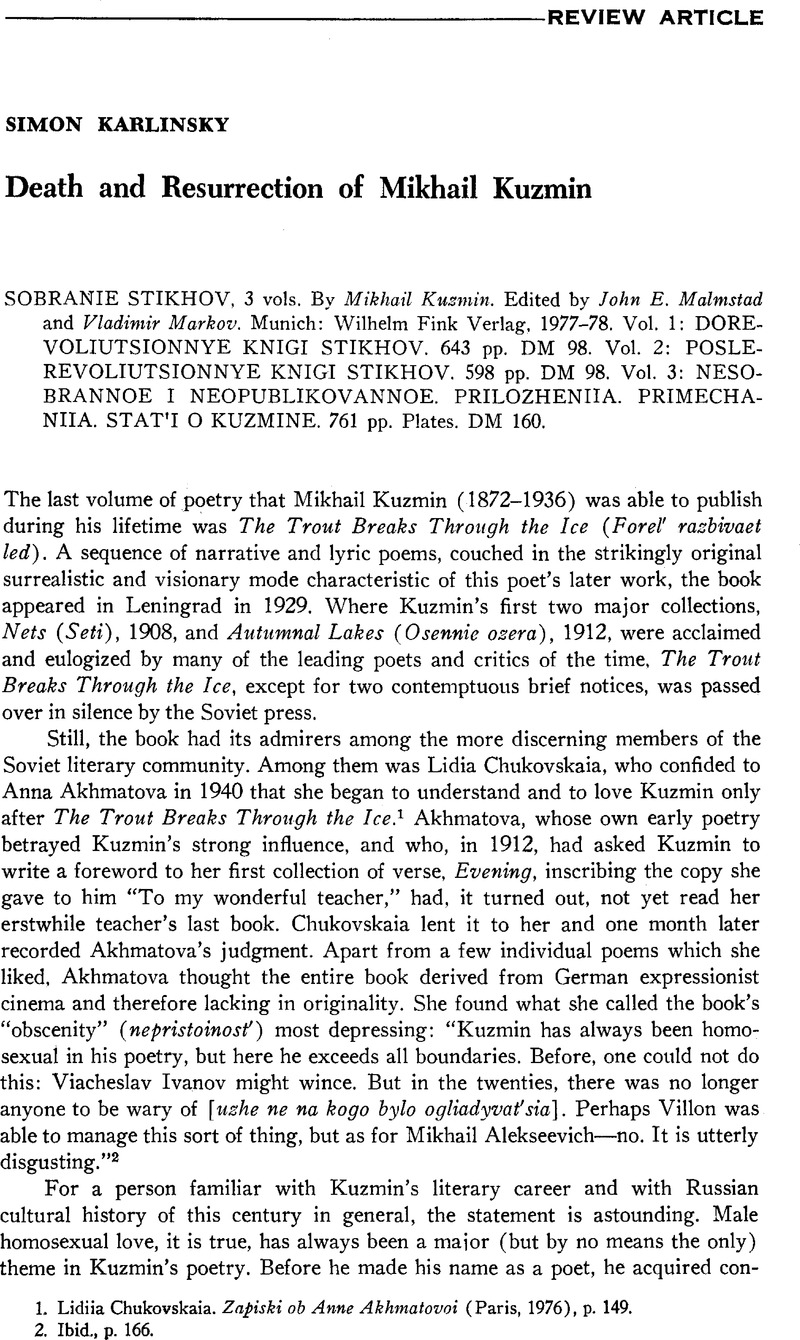Article contents
Death and Resurrection of Mikhail Kuzmin
Published online by Cambridge University Press: 27 January 2017
Abstract

- Type
- Review Article
- Information
- Copyright
- Copyright © Association for Slavic, East European, and Eurasian Studies. 1979
References
1. Chujcpvskaia, Lidiia. Zabiski ob Anne Akhmatovoi (Paris, 1976), p. 149.Google Scholar
2. 'lbid, , .p., 166.
3. “Kuzmin occupies one of the most important places among the contemporary Russian poets. Very few are able to achieve such astounding harmoniousness of the whole [combined] with such free variety of the component parts. Furthermore, being a spokesman for the views and emotions of a whole array of people, united by a common culture, who have quite justly risen to the crest of life's wave, Kuzmin is a poet with organic roots [pochvennyi poet] …” ( N., Gumilev, Sobranie sochinenii, vol. 4 [Washington, D.C., 1968], p. 307 Google Scholar; originally in Apollon, 1912, no. 8).
4. Viacheslav, Ivanov, Sobranie sochinenii, vol. 2 (Brussels, 1974), p. 750.Google Scholar Kuzmin appears in this diary under the name of “Antinous.”
5. See Timenchik, R. D., Toporov, V. N., and Tsiv'ian, T. V., “Akhmatova i Kuzmin,” Russian Literature, July 1978, pp. 213–305Google Scholar, for a detailed examination of the literary relationship between these two poets.
6. A typical example of this kind of uninformed treatment of Kuzmin is found in Renato Poggioli, , The Poets oj Russia 1890-1930 (Cambridge, Mass., 1960).CrossRefGoogle Scholar
7. Kuzmin's major collections are Nets, Autumnal Lakes, Clay Doves ﹛Glinianye golubki, ca. 1915), The Guide ﹛Voshatyi, 1918), Otherworldly Evenings ﹛Nezdeshnie vechera, 1923), Parabolas ﹛Paraboly, 1923), and The Trout Breaks Through the Ice. The edition under review also contains six lesser collections of verse published by Kuzmin, his verse play for puppets Vtornik Meri ﹛Tuesday at Mary's, 1921), and volume 3 contains a large number of previously uncollected or unpublished poems.
8. Aleksandr, Blok, Sobranie sochinenii, vol. 5 (Moscow-Leningrad, 1962), p. 183.Google Scholar
9. Ibid., vol. 6, p. 440.
10. The authors of an otherwise fine and informative study, “Akhmatova i Kuzmin” (see note S above), jeopardize their scholarly probity by their occasional moralizing attempts to justify Akhmatova's later aversion to Kuzmin by referring to the latter's supposed mysogyny and amorality. Their strictures, when placed next to John E. Malmstad's informed and sympathetic biography, make instructive reading.
- 2
- Cited by


